Announcements
Useful links
- Data Reduction: DRAGONS and Gemini IRAF
- Advanced Data Reduction Tips - contains solutions to some of the more serious issues you may encounter.
- GMOS IFU data reduction tutorial
- GMOS Reduction Cookbook (hosted on US NGO pages, will open a new window)
- FAQ
- Observation planning guide
Data Format
- GMOS data format: Raw data
- GMOS data format: Processed data
- Generic Gemini data format
Raw data
The raw images from GMOS are MEF files with a PHU and one or more pixel extensions.
Each of the three chips in the GMOS-N and GMOS-S Hamamatsu arrays is read out through 4 amplifiers. Thus, in the 12-amplifier mode currently used for science applications, the data file contains 12 extensions in total. The overscan region is 32 pixels wide. See diagram below.
Each of the three chips in the GMOS-N and GMOS-S original EEV arrays could be read out through one or two amplifiers (left and right). In the two-amplifier mode the output data file then contains 6 fits extensions (see diagrams below). Each of the six image sections has an accompanying overscan region 32 pixels wide. In one-amp mode the data file contains three extensions, one per chip, again with a 32-pixel wide overscan section. The one-amplifier mode has been the most used for science applications with the original EEV detectors. With the upgraded e2v deep-depletion GMOS-N (e2vDD) array all data is taken in two amp mode.
Binning: When pixel binning is used, the resulting datafile still contains overscan regions that are 32 samples wide.
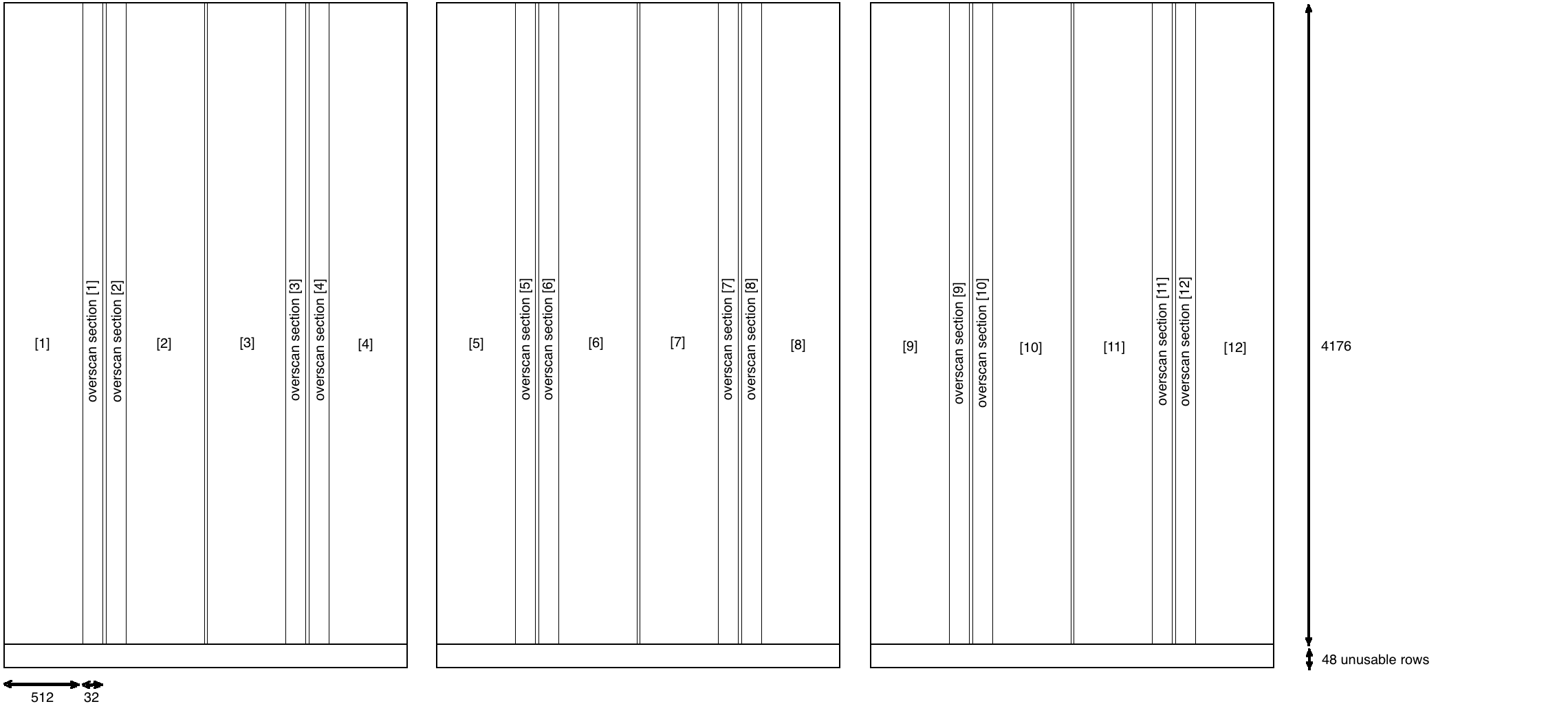
Layout of GMOS-N and GMOS-S Hamamatsu detector arrays and structure of the output data file when reading out in 12-amp mode, with unbinned pixels.
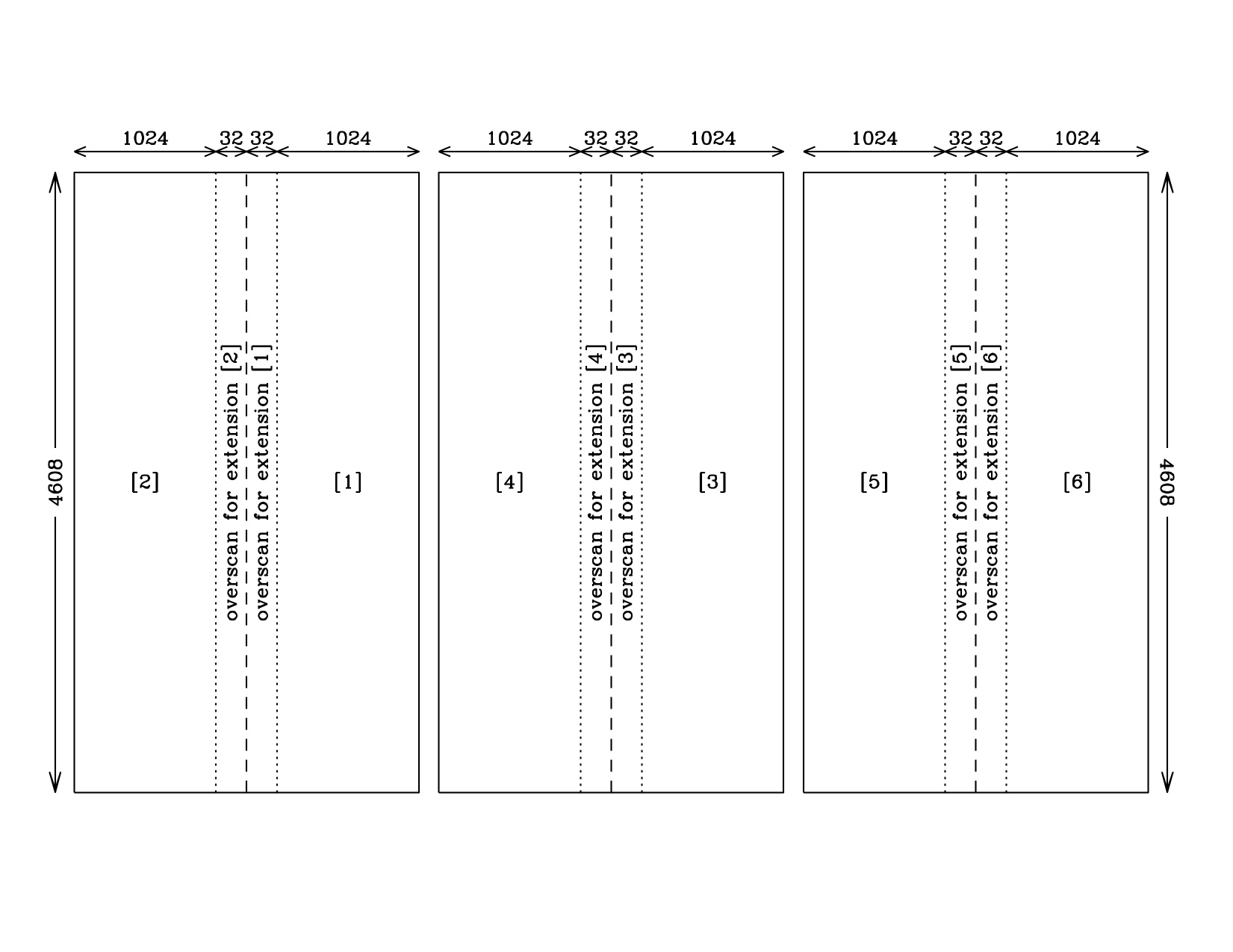
Layout of GMOS-N EEV or e2vDD detector array and structure of the output data file, when reading out in 6-amp mode, with unbinned pixels.
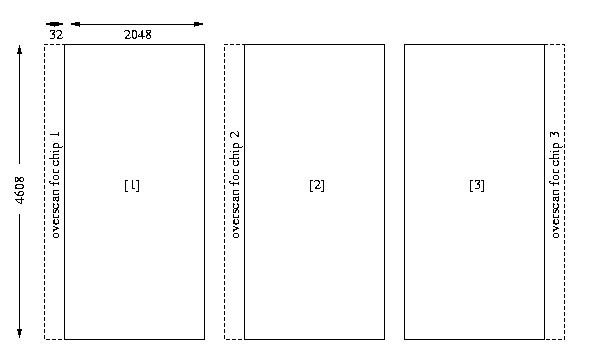
Layout of GMOS-N original EEV detector array and structure of the output data file, when reading out in 3-amp mode (using the 'best' three amps, R,R,L). Note the overscan regions are not in the same place for each chip.
Processed data from GMOS
Imaging data
As part of the data quality assessment most GMOS imaging data are processed as follows.
- Subtraction of the overscan level
- Subtraction of bias image
- Correction for the differences in gain for the three detectors
- Flat field correction
- Mosaicing of the images from the three detectors into one image
After these processing steps the output image is a MEF file with a PHU and one pixel extension.
For observations that consist of several exposures at different dither positions, the images are registered and co-added. In the process of co-adding the images are cleaned for cosmic-ray-events and bad pixels, including the gaps between the detectors if the dither steps are of sufficient size. An example of a reduced co-added image is shown on the figure below.
Note that Gemini does not distribute reduced science imaging data with the exception of imaging taken for MOS mask design (aka pre-imaging).

A reduced and co-added GMOS imaging observation. For this observation a guide star was used inside the imaging field of view. Thus, the OIWFS is vignetting a small part of the field.
Photometry with the GMOS Hamamatsu CCD mosaic
Flat fielding and photometric calibration of the GMOS Hamamatsu CCD mosaics is complicated by the fact that the individual CCDs have different quantum efficiency (QE) characteristics.
The conversion from instrumental to standard magnitudes is provided by:
mstd = mzero - 2.5 log10 (N[e-]/exptime) - k (airmass-1.0) + CT (color1 - color2)
where mstd is the standard magnitude, mzero is the photometric zero point, N[e-] is the total number of electrons above the background within an aperture, exptime is the exposure time, k is the extinction coefficient, and CT is the color term. The zero points and color terms for any filter depend on the convolution of the filter curve with the CCD QE curve. As a result, each different type of CCD in the GMOS detector mosaic has a different zero point and color term. For the GMOS-N detector array, CCD1 (CCDr) and CCD3 (CCDb) are both of type BB and should have very similar zero points and color terms, while CCD2 (CCDg) is of type HSC. For the GMOS-S detector array, all three CCDs are of different types. CCD1 (CCDr) is of type SC, CCD2 (CCDg) of type HSC, and CCD3 (CCDb) of type BB. The following figure illustrates the effects of the QE differences between the two CCD types used in the GMOS-N detector mosaic for an A0V and a K7V stellar template taken from the Pickles 1998 stellar spectral flux library.
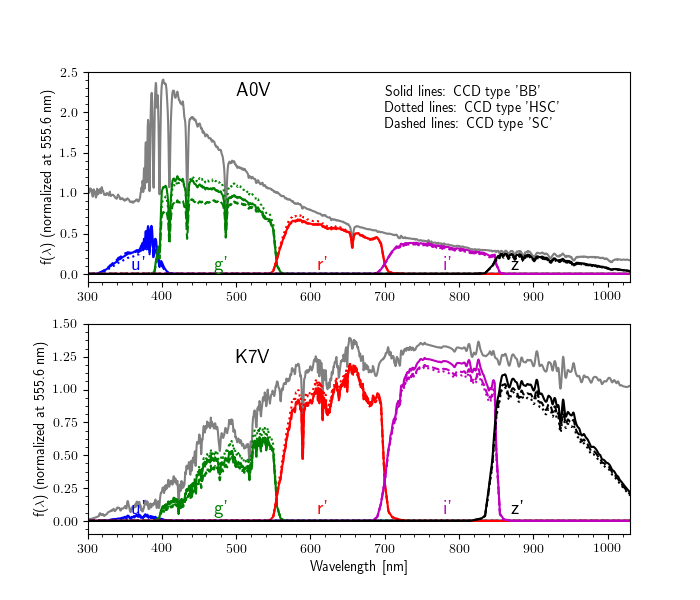
Visualization of the effects of the different CCD QEs when detecting an A0V and K7V stellar template through the standard GMOS broad-band filters. The stellar spectrum (gray line) is convolved with the u’ (blue), g’ (green), r’ (red), i’ (magenta), and z’ (black) filter curves and with the QE curves corresponding to the ‘BB’ (solid line), ‘HSC’ (dotted line), and ‘SC’ (dashed line) CCD types as used by the GMOS Exposure Time Calculators.
Note that the color dependence caused by the QE differences affects both the source and background detection. This implies that the flat fielding step can additionally introduce systematic errors in the photometry between the different CCDs if the flat field source (e.g. the twilight sky) has a different color than the night sky. Any difference in color will cause discontinuities in the flat-fielded backgrounds from one CCD to the other. The color difference will also lead to artificial multiplicative factors on those CCDs that are not used as the reference for the flat-field normalization.
Photometric accuracy predictions from synthetic color terms
Because of the CCD-dependent color terms, accurate photometry can only be achieved if the CCDs are calibrated individually. The difference in color terms between the CCDs is most noticeable in the g’-band. This is illustrated in the following figures for GMOS-N and GMOS-S showing the predicted magnitude differences between CCD2 and CCD1 or CCD3 for a range of stellar templates with different colors based on the GMOS filter and QE curves. The color terms are represented by the slopes of the data for each filter. This synthetic analysis predicts that the photometry of a blue (g’-r’ ~ -0.6) and a red (g’-r’ ~ 1.5) star can differ by up to 6% in g’ if the CCD-dependent color terms are neglected. This means that stacking of images detected on different CCD types is not an option if the highest levels of photometric accuracy are required. Note that these plots are meant for illustration purposes only. Any photometric calibration should be based on the photometric coefficients derived from standard star observations rather than the approximate filter and QE curves used in this exercise.
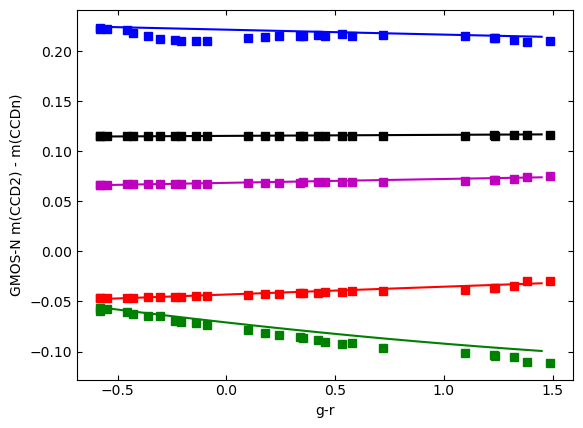
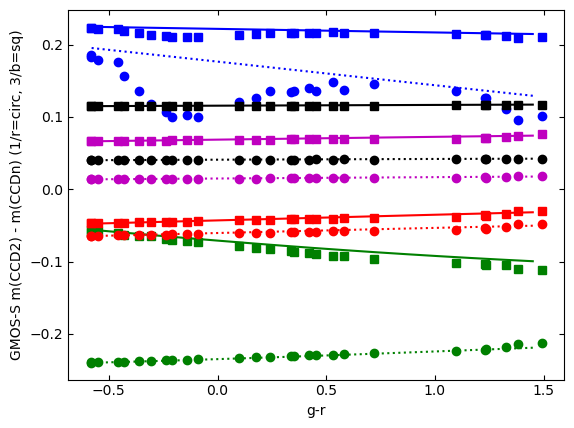
Synthetic magnitude differences between CCD2 and CCD1 or CCD3 for GMOS-N (upper panel) and GMOS-S (lower panel). The plots are based on a range of stellar templates with g-r colors between -0.6 and 1.5. The lines assume power-law spectra, the data points are based on main-sequence stars from the Pickles spectral atlas. Detections through the u’, g’, r’, i’, z’ filters are shown in blue, green, red, magenta, black color, respectively. (Note that the u’-band filter is currently not available for GMOS-N.) Upper panel (GMOS-N): The solid lines and squares show the differences between CCD2 (HSC-type) and CCD1 or CCD3 (both BB-type). Lower panel (GMOS-S): The solid lines and squares refer to the differences between CCD2 (HSC-type) and CCD3 (BB-type); the dotted lines and circles refer to the differences between CCD2 (HSC-type) and CCD1 (SC-type). The unusual shape of the u'-band curve for the GMOS-S CCD1 is due to artifacts in the QE curve. Note that these plots should not be used for any science calibration purposes!
Photometric standard star data
Both GMOS instruments have started to collect observations of standard star fields in which the same stars are consecutively detected on each of the three CCDs. These special photometric standard star observations are obtained as part of the instrument performance monitoring. The photometric standard stars observed as part of the regular baseline calibrations are only obtained at a single position on the CCD mosaic.
For GMOS-N, the special photometric standard star observations with detections on each of the three CCDs have been implemented since semester 2021A. The GMOS-N data can be retrieved from the Gemini Observatory Archive using this search link. To obtain data from other semesters, please update the Program ID to the required semester, e.g. GN-2021B-ENG-51 for 2021B. For GMOS-S, the corresponding data can be retrieved under this search link by replacing GS-2020B-ENG-201 with the required semester. (For GMOS-S data from semester 2017B and earlier, please use "SV" instead of "ENG".) Efforts are underway to provide color terms that can be used to calibrate data processed with a new DRAGONS recipe that is currently being developed to reduce the three GMOS CCDs individually.
Recommended observing strategies
Photometric science cases requiring better than ~5% accuracy
GMOS users interested in obtaining relative photometry with better than 5% accuracy should aim to keep their targets on the central CCD (CCD2), especially for observations involving the g’ and r’ bands. Stacking images of a target detected on different CCDs is not an option if high photometric accuracy is required. If the required field-of-view is larger than the field covered by the central CCD, dithers should be chosen small enough to keep the primary targets of interest on the same CCD. The CCDs should be reduced individually to avoid introducing artificial factors from color mismatches between the twilight flats and night sky background. A new DRAGONS recipe to reduce the three CCDs in GMOS imaging data individually is currently being developed. The photometric calibration of the individual CCDs should take into account the CCD-dependent zero-points and color terms. As mentioned above, such color terms can be derived from observations of standard star fields in which the same stars are consecutively detected on each of the three CCDs.
Wide field imaging with relaxed photometric requirements
PIs requiring coverage over a wide field-of-view might consider dithering their images between the three CCDs to obtain a continuous coverage across the chip gaps and reduce the data as a mosaic. The trade off is that such data will not be able to achieve the highest levels of photometric accuracy. Flat-fielding such data based on the baseline twilight flats can result in residual discontinuities in the backgrounds of the individual CCDs if the flat field has a different color than the night sky. This is equivalent to introducing artificial normalization factors through the flat-fielding, which affects not just the background but also the source counts. (As described above, the magnitude of the effect depends on the filter.)
The IRAF-based GMOS imaging reduction steps can be modified to minimize such artificial normalization factors:
- Process individual twilight flats from the same observing date:
- Bias and overscan subtraction (gireduce task)
- Relative QE correction (gqecorr task): Make a local copy of the file gmosQEfactors.dat (which is located in IRAF directory gmos$data). Tweak the local copy of the file (e.g. gmosQEfactors_twilight.dat) until the background flux on all three CCDs is the same. (gqecorr can be configured to use the custom gmosQEfactors_twilight.dat file.) Use the custom gmosQEfactors_twilight.dat only with the twilight dataset for which it was modified.
- Combine the processed individual twilight flats into a master flat (giflat task). This master twilight flat is normalized and corrected for relative QE differences between the CCDs.
- Process individual science frames:
- Bias and overscan subtraction (gireduce task with fl_flat turned off)
- Relative QE correction (gqecorr task)
- Divide each of the processed science frames from step 3 by the master twilight obtained from step 2
- Mosaic the flat-fielded images
A cl script has been prepared that can be used to perform the calculations for step 1.b (i.e. compute the average CCD1 and CCD3 factors for a given set of twilight flats and create a local gmosQEfactors file to be called by the IRAF task gqecorr. The cl script is available in zip format here. Please see the description at the top of the script for further instructions.
The above workaround is currently only accessible via the GMOS IRAF reduction tools, because the current DRAGONS recipe for reducing GMOS images as a mosaic relies on matching flat fields rather than offering a separate QE-correction step. While this workaround results in mosaicked images with a flat background, accurate photometry still requires taking into account the CCD-dependent color terms. This also means that extended objects might still show discontinuities in their count levels across the CCD borders.
Sky flats
While the GMOS baseline imaging flats are based on twilight flats, programs with strong requirements for accurate flat fielding have the option to define sky flats as part of their science program. The required time should be included in the Phase I program time request. For deep exposures on empty fields it might be possible to construct sky flats from dithered on-source exposures. For crowded fields or extended sources, separate exposures on empty sky fields might be needed. (Note that achieving sufficiently high background counts in sky flats can be time consuming, especially in blue filters.) Sky flats will simplify the relative normalization of the CCDs, but any photometric measurements will still need to take into account the CCD-dependent color terms.
Wavelength zeropoint checks using sky lines
If CuAr arc exposures were obtained in the form of daytime baseline calibrations - the default for any GMOS spectroscopic configuration covering sky emission lines until the end of 2024A - flexure effects between the on-sky science data and daytime arcs might result in wavelength zeropoint offsets. For GMOS-N, maximum shifts of the order of 1-2 nm have been observed between certain telescope elevation and cass rotator angles during flexure tests. If the science goals depend on an accurate wavelength zeropoint, users are recommended to use the sky emission lines in the science data to test for offsets in the wavelength calibration and apply a correction if necessary. The basic steps to perform this test include:
- Reducing the science exposures without sky subtraction
- Comparing the sky lines in the wavelength-calibrated science data with sky line lists (Note that this might include a conversion from vacuum to air wavelengths depending on the type of wavelengths used in the sky line list.)
- Correcting the wavelength solution of the fully reduced science data (i.e. including sky subtraction) by the wavelength offset found in the previous step
DRAGONS long-slit tweak for interactive sky-line-based corrections
The DRAGONS GMOS longslit data reduction currently uses GCAL CuAr arcs for the wavelength calibration. A customized recipe can be used to include an interactive overlay with a sky line list, which allows the user to apply a wavelength offset if needed. The customized recipe requires the UVES sky emission list (Hanuschik 2003, Astronomy & Astrophysics, 407, 1157) for the overlay, which is provided here. Download the customized recipe (remove the .txt from the file name to create a .py file) and the sky line list into your current directory.
The reader is referred to the tutorial on GMOS Longslit Data Reduction with DRAGONS for a general description of the DRAGONS data reduction steps using either the "reduce" command line or the "Reduce" class. The customized recipe replaces the default recipe used for processing the science files.
To run the customized recipe instead of the default science reduction recipe, use:
reduce -r GMOS_tweak.reduceScience -p center=<row> @sci.lis (where <row> is the number of the row that will be used for the sky line overlay)
When using DRAGONS via the "Reduce" class, the customized recipe and center row are configured via:
During the reduction, the customized recipe will open a plot of the sky spectrum from the specified row compared to a model spectrum based on the UVES line list. This plot can be visually analyzed for shifts between the observed and reference sky lines. It might be necessary to zoom into regions with sky lines to clearly see the overlay and identify possible shifts. The user is prompted to enter the measured wavelength shift in nm. The shift is applied and the overlay is shown again for further iteration if needed. As soon as a shift of zero is provided (or simply hit <enter>) the recipe will go on to the next science spectrum with the overall shift from the previous spectrum already applied. The user is again promted to apply further shifts as needed. After all spectra have gone through this process, the rest of the reduction will continue and the output wavelength solution includes the wavelength shifts.
Turning off the sky subtraction in DRAGONS
While not necessarily required for the above customized recipe, users might be interested in fully turning off the DRAGONS sky subtraction for testing or data quality assessment purposes.
In DRAGONS v3.1, turning off the sky subtraction requires
- Deleting (or commenting out) p.skyCorrectFromSlit() from the reduceScience recipe, and
- Running the recipe with -p extractSpectra:sky_subtract=False
From DRAGONS v3.2, the sky subtraction can be turned off by simply running the normal recipe with -p skyCorrectFromSlit:skip_
Fringing
The GMOS-N and GMOS-S EEV detectors had significant fringing in the red. The GMOS-N DD E2V detectors, which were in operation until February 2017, and the new GMOS-N and GMOS-S Hamamatsu detectors exhibit much less fringing than the original EEV detectors. The pages in this section show examples of fringe frames in imaging mode as well as science data before and after correction for fringing.
The GMOS-N E2V DD CCDs, used between Nov 2011 and Feb 2017, had much weaker fringing than the original GMOS-N EEV CCDs or the new Hamamatsu CCDs. This page shows examples of fringe frames in imaging mode.
Raw fringe frames for i', Z, z', and Y filters can be downloaded from the Gemini Observatory Archive. To retrieve fringe frames taken with the EEV and DD E2V CCDs since 2009, please search for Target Name "Fringe Frame". (Please note that the DD E2V CCDs were installed in Nov 2011 and replaced by the Hamamatsu detectors in February 2017.)
To retrieve fringe frames taken with the Hamamatsu detectors, please specify Target Name "Blankfield".
(Note that filenames beginning with RG and _FRINGE in the Data Label indicate processed frames.)
Hamamatsu CCDs:
The Hamamatsu CCDs for GMOS-N have similar fringing properties as observed for the GMOS-S Hamamatsu CCDs. Fringing is negligible in i' and Z filters. Fringing is noticeable in z' and Y filters. The worst fringing is in the middle chip, at the level of about 1% of the background in z' and almost 2% on average in Y. Below we show fringe frames for i' (top left), Z (top right), z' (bottom left), and Y (bottom right) at the same scaling. These were taken in March-April 2017. We highly recommend for z' and Y imaging to take enough dithers to generate your own fringe frames.
 |
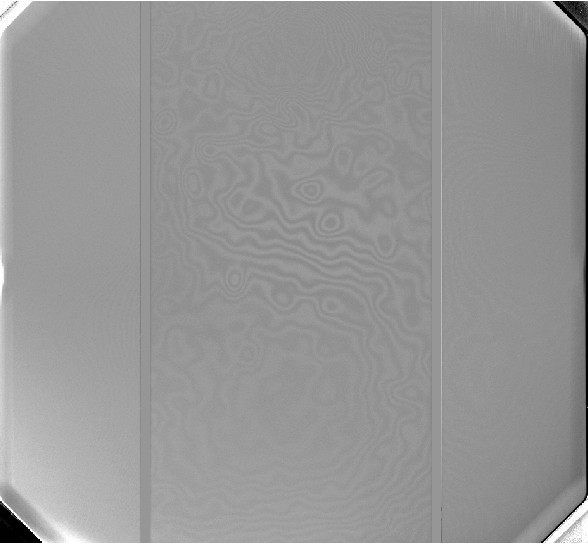 |
 |
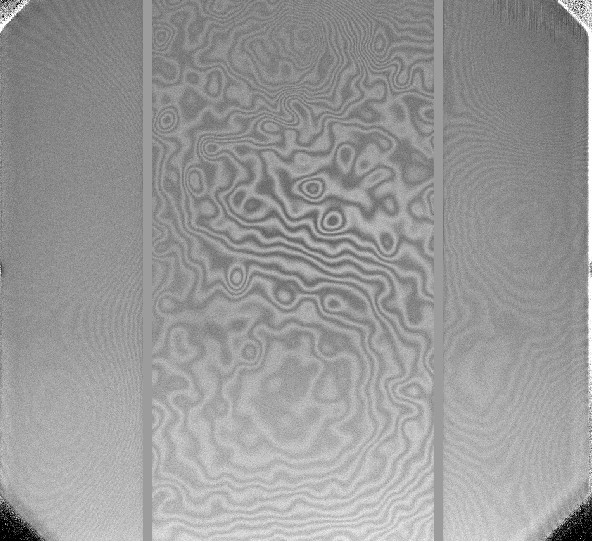 |
![Chart showing Relative Fringe Strength vs Column [pix] for z' and Y filters](/sciops/instruments/gmos/FringeYzHam.jpg)
Upgraded E2V DD CCDs:
The data shown for the E2V DD CCDs were taken between Dec 2011 - Feb 2012, on photometric nights in dark time. Fringing in the z'-filter is typically +-0.3% of the background, while the i'-filter fringing is less than +- 0.15% of the background.
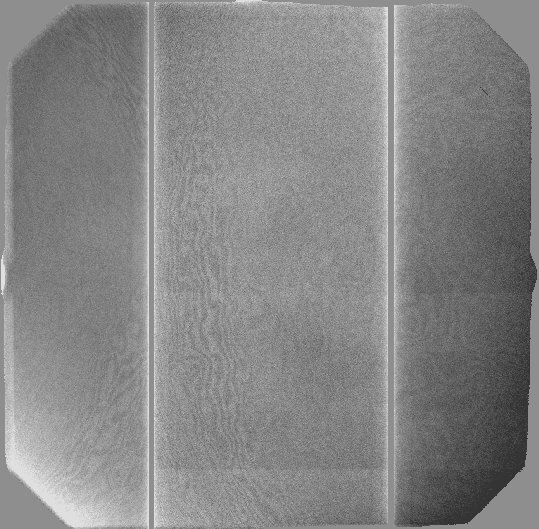 |
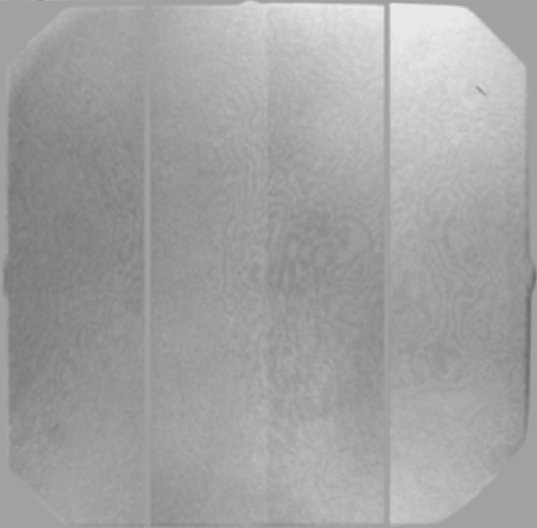 |
|
z'-filter fringe frame. |
i'-filter fringe frame, median filtered with a box 17 pixels by 17 pixels in order to increase the signal-to-noise to make the fringes more apparent. |
A z'-band science frame without fringe subtraction. Note the fringing is much weaker than in the original EEV CCDs as shown above.
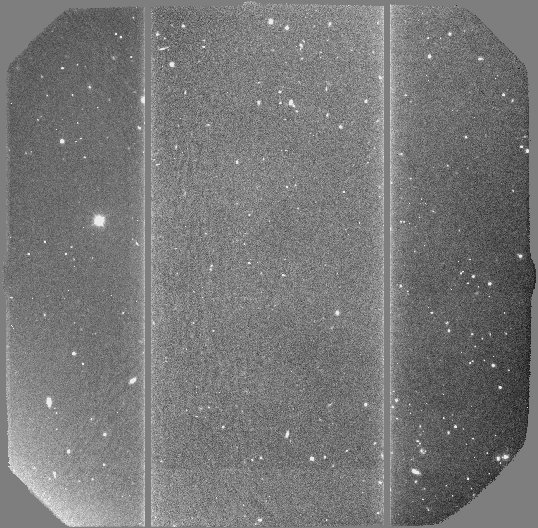
A comparison of z'-band fringing between the original and upgraded EEV CCDs:
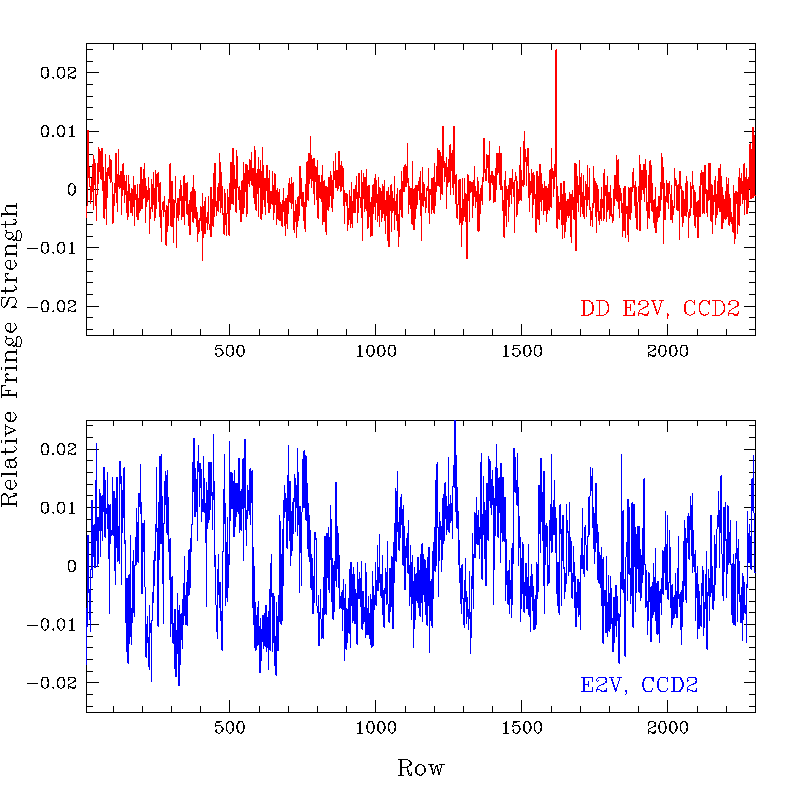
This shows a cut along a single column. Fringing in the DD E2V CCDs in the z'-band is about a tenth as strong as in the original EEV CCDs.
The original EEV CCDs
The data shown for the original EEV CCDs were obtained the night of August 19-20, 2001, during the commissioning of GMOS-N. This was close to new moon, and the sky was photometric. The fringe strength in the z'-filter is typically +-2.5% of the background, while in the i'-filter the fringing is +-0.7% of the background.
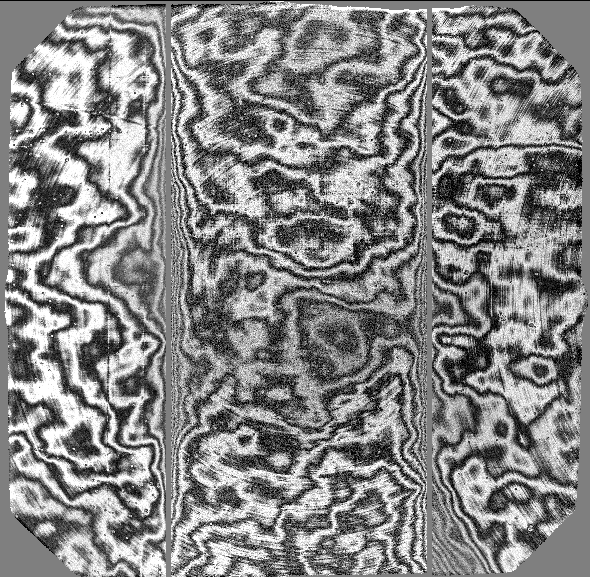 |
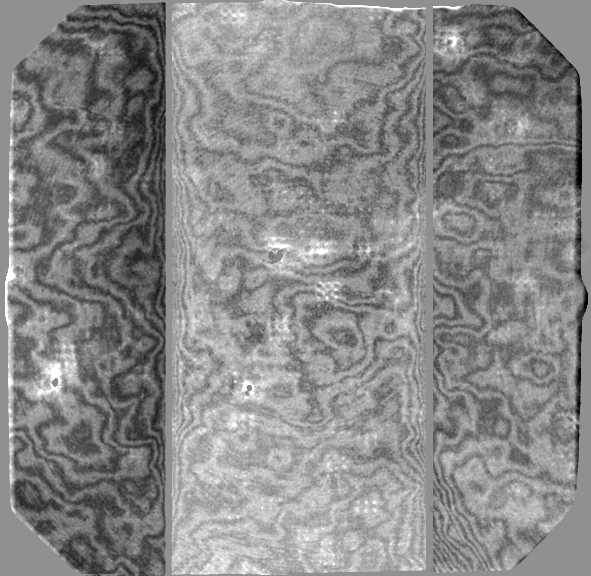 |
|
z'-filter fringe frame. |
i'-filter fringe frame. The images was median filtered with a box 17pixels by 17 pixels in order to increase the signal-to-noise. Because this fringe frame was constructed from only 6 science exposures, artifacts are seen from insufficient cleaning of signal from objects. The signal in the artifacts is typically less than 1% of the background level. |
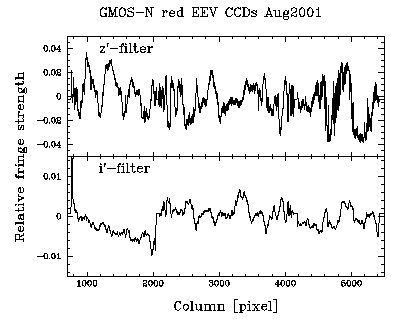
Relative strength of the fringes in the z'- and the i'-filter.
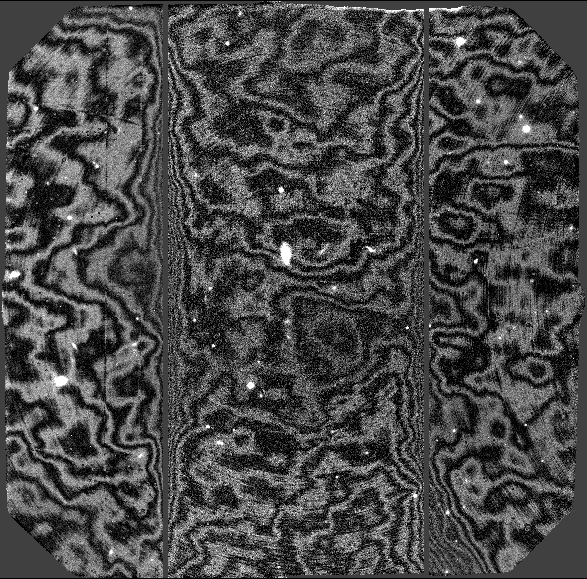 |
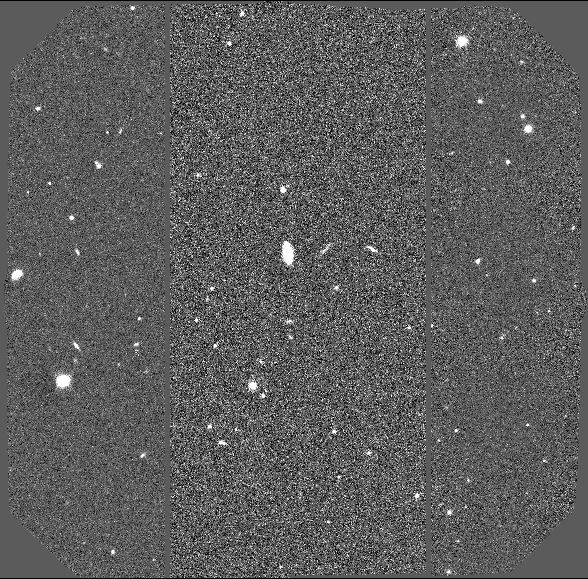 |
z'-filter science frame before and after fringe subtraction.
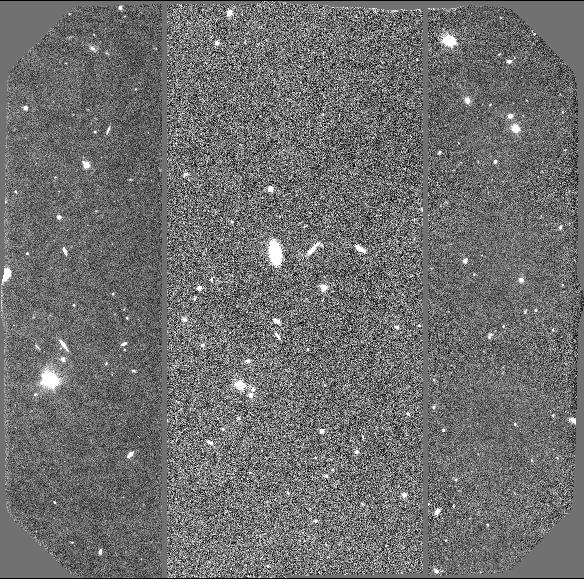 |
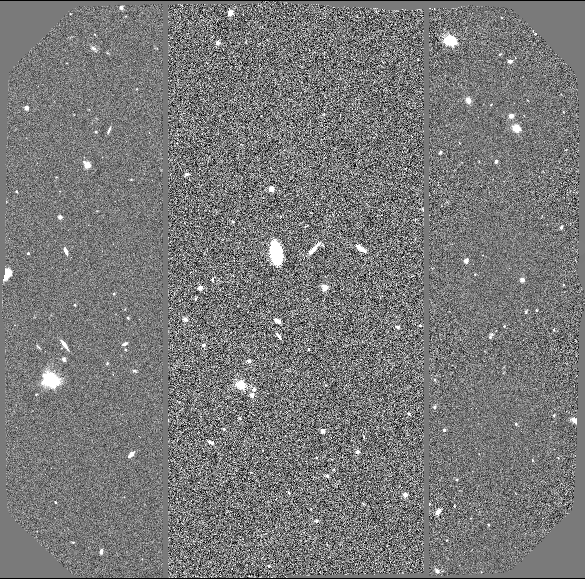 |
i'-filter science frame before and after fringe subtraction.
GMOS-S
The new GMOS-S Hamamatsu CCDs have significantly less fringing than the EEV detectors. The fringing in i' is negligible (compared to the ~67% in i' on the EEVs), as well as in CaT and Z; about 1% in z' and ~2.5% in Y. Example snapshots below show z' band (top left), i'(top right), Z (bottom left) and Y (bottom right) fringe frames.

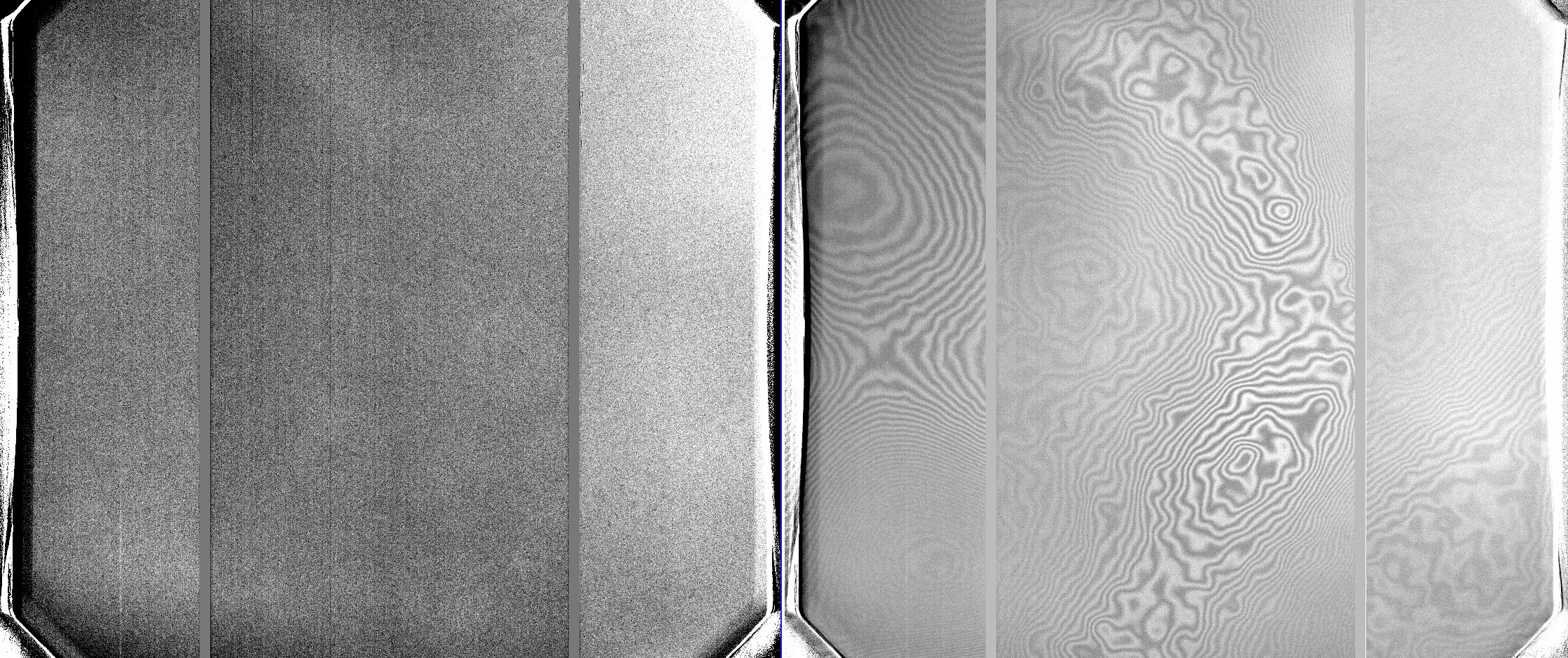
------------
The GMOS-S EEV (no longer available) CCDs have significant fringing in the red. This page shows examples of fringe frames in imaging mode in the i'-filter and the z'-filter as well as science data before and after correction for the fringing.
Recent fringe frames for both i' and z' are available from the Gemini Observatory Archive. To retrieve either the raw or the processed frames one can follow these steps (eg.):
- - Under Instrument select GMOS-N and/or GMOS-S
- - In Target Name enter Fringe or Fringe Frame (both target labels have been used)
- - in Filters enter either i_G0327 or z_G0328
- - In Binning enter either 1 1 or 2 2
Imaging Fringe Frames are taken on a one-set-per-semester basis. The ones shown below were obtained in November/December 2010 and the corresponding processed fringe frames area available through the GSA. The latest fringe frames were observed on 2013A and are being processed.
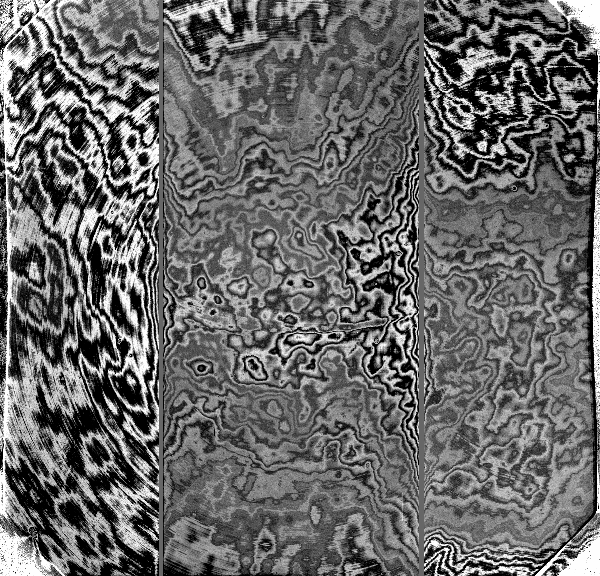 |
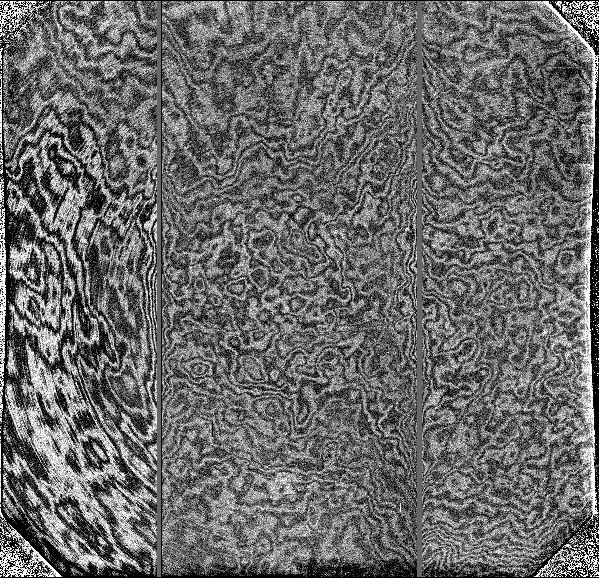 |
|
z'-filter fringe frame. |
i'-filter fringe frame. |
Example of science data before and after correction for the fringing. The data were obtained the night of May 24-25, 2003 during the commissioning of GMOS-S. The images are from dataset GS-2003A-SV-228.
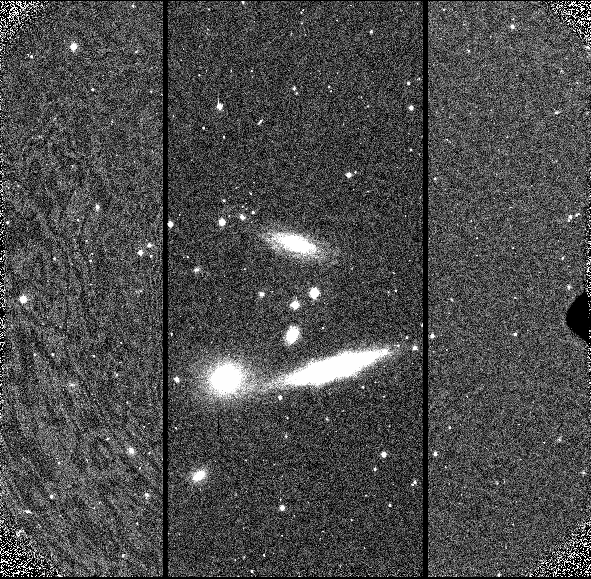 |
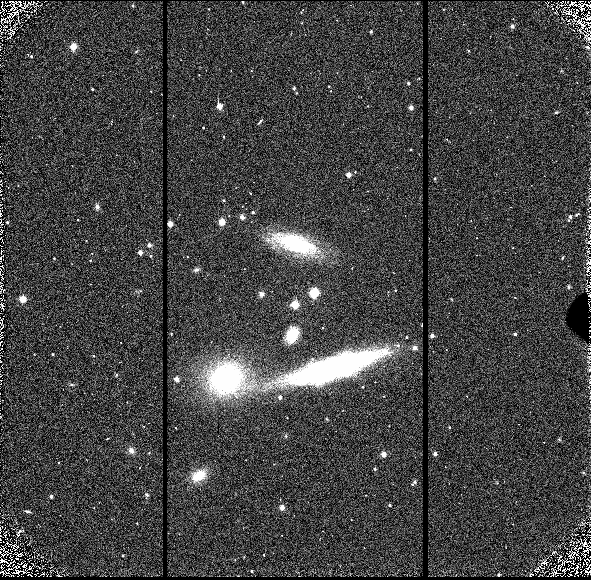 |
i'-filter science frame before and after fringe subtraction.
Scattered light
Both GMOS-N and GMOS-S suffer fairly significant scattered light in spectroscopic mode. The six gratings exhibit different levels of scattered light, with some gratings being more affected by red scattered light than blue (some examples shown below). The scattered light affects both science observations and GCAL lamp (flat and CuAr) calibration exposures. Note that the GCALflat lamp is very red, and scattered light from astronomical sources will have different relative strengths of blue and red scattered light depending on their intrinsic spectral properties.
The two dimensional shape of the scattered light is rather smooth and spatially fills the entire detector, as can be seen from the example images below. The result of this is that a faint science target can suffer significant contamination from a much brighter object within the GMOS field of view (eg. bright objects also falling on the longslit or bright alignment targets in MOS masks). Because the scattered light character is spatially smooth it is removed fairly adequately as part of the sky subtraction procedure, but the increased Poisson noise can negatively impact the final signal-to-noise of the science target. This is particularly a concern for very faint targets observed in the blue during new moon, when the nominal sky background is very low.
In order to minimize the effects of scattered light from other bright targets one may wish to consider one of the following strategies:
- Avoid placing much brighter objects on the slit, IFU, or MOS slitlet with your science target if there is no scientific reason to include them.
- For MOS, it may be beneficial to include an offset iterator in your science observation to offset the field a small amount (eg. q=5 arcsec) after the mask is aligned in order to move the alignment stars out of their 2 arcsec wide boxes. If adopting this strategy it is essential to ensure that either the MOS science slitlets have sufficient length to accommodate the offset or employ the corresponding y-offset to the science targets when designing the MOS mask.
- If you need to check how scattered light looks for a particular configuration, you may fetch the specific configuration desired from the archive or request an advance test flat be obtained for your program.
Unfortunately, there is little that can be done to avoid scattered light from the science target itself, particularly when observing with the lower resolution gratings. For the higher resolution gratings, it may be advantageous to observe through a broadband filter in order to avoid scattered light contamination from wavelengths beyond the region of scientific interest. Any of these strategies should be adopted with care, we recommend you consult with your contact scientist or the GMOS-N/S instrument scientist if you are concerned with minimizing the effects of spectroscopic scattered light on your science data.
The following images illustrate the spatial distribution of scattered light in longslit spectral images from a single bright star. Both a red star and a blue star were observed on two separate occasions, these data all used the B600 grating.
| EG131 (blue star) | ||||
| Central Wavelength 400nm (262 - 538 nm) | ||||
| no filter | g-filter | r-filter | i-filter | z-filter |
![EG131 B600 400nm no filter. [EG131 B600 400nm no filter]](/sciops/instruments/gmos/B600n_400nm_none_bluestar.jpg) |
![EG131 B600 400nm r filter. [EG131 B600 400nm r filter]](/sciops/instruments/gmos/B600n_400nm_r_bluestar.jpg) |
![EG131 B600 400nm i filter. [EG131 B600 400nm i filter]](/sciops/instruments/gmos/B600n_400nm_i_bluestar.jpg) |
![EG131 B600 400nm z filter. [EG131 B600 400nm z filter]](/sciops/instruments/gmos/B600n_400nm_z_bluestar.jpg) |
|
| Central Wavelength 900nm (762 - 1038 nm) | ||||
![EG131 B600 900nm no filter. [EG131 B600 900nm no filter]](/sciops/instruments/gmos/B600n_900nm_none_bluestar.jpg) |
![EG131 B600 900nm g filter. [EG131 B600 900nm g filter]](/sciops/instruments/gmos/B600n_900nm_g_bluestar.jpg) |
![EG131 B600 900nm r filter. [EG131 B600 900nm r filter]](/sciops/instruments/gmos/B600n_900nm_r_bluestar.jpg) |
||
| HD195275 (red star) | ||||
| Central Wavelength 400nm (262 - 538 nm) | ||||
| no filter | g-filter | r-filter | i-filter | z-filter |
![HD195275 B600 400nm no filter. [HD195275 B600 400nm no filter]](/sciops/instruments/gmos/B600o_400nm_none_redstar.jpg) |
![HD195275 B600 400nm r filter. [HD195275 B600 400nm r filter]](/sciops/instruments/gmos/B600o_400nm_r_redstar.jpg) |
![HD195275 B600 400nm i filter. [HD195275 B600 400nm i filter]](/sciops/instruments/gmos/B600o_400nm_i_redstar.jpg) |
![HD195275 B600 400nm z filter. [HD195275 B600 400nm z filter]](/sciops/instruments/gmos/B600o_400nm_z_redstar.jpg) |
|
| Central Wavelength 900nm (762 - 1038 nm) | ||||
![HD195275 B600 900nm no filter. [HD195275 B600 900nm no filter]](/sciops/instruments/gmos/B600o_900nm_none_redstar.jpg) |
![HD195275 B600 900nm g filter. [HD195275 B600 900nm g filter]](/sciops/instruments/gmos/B600o_900nm_g_redstar.jpg) |
![HD195275 B600 900nm r filter. [HD195275 B600 900nm r filter]](/sciops/instruments/gmos/B600o_900nm_r_redstar.jpg) |
||
Scattered light longslit B600 spectral images arising from a single bright star. Click to view full images.
The following two sets of images illustrate the relative contribution of scattered light from GCALflat data. All data were taken using identical GCAL configurations and exposure times. The B600, R400 and gratings are compared at both red and blue central wavelengths. Because the GCAL flat lamp is very red the effect of red scattered light in blue data is much more noticeable than the effect of blue scattered light in red data for both gratings. Because identical configurations and display stretches are used one can see how the B600 grating is more affected by red scattered light than the R831 grating.
Scattered light MOS B600 and R831 spectral images corresponding to GCALflats centered on 400 and 850nm. The MOS mask consists of two widely separated (in y) slitlets (centered in x). The scattered light images in blue light are very faint, mainly due to the lack of blue light in the GCAL flat lamp. The scattered red light images are very smooth for blue central wavelengths, though for red central wavelengths they show some structure both spatially and in wavelength implying that some fraction of the scattered light contribution is dispersed light. All exposures were 120s long using the ND4-5 filter in GCAL. All images are displayed with the same stretch to reveal the difference in scattering between the two gratings. Click to view full images.
Nod & Shuffle performance and examples
The data shown on this page were taken during the commissioning of Nod & Shuffle on GMOS-N in August 2002.
![[NS raw longslit]](/sciops/instruments/gmos/NS/NSraw.jpg)
The figure above shows a raw frame from a longslit Nod & Shuffle observation. The dispersion is in the X-direction, red to the left, blue to the right. The slit spans the central third of the frame in the y-direction. The two set of spectra correspond to the spectrum from the A-position and the spectrum from the B-position. For this observation, the nod was along the slit and the objects are in the slits in both nod-positions.
![</center>[NS combined longslit]](/sciops/instruments/gmos/NS/NSreduccombine.jpg)
The figure above shows the result of processing four longslit Nod & Shuffle exposures as follows: Bias subtraction, processing with gnsskysub to shift and subtract the two nod-positions, and combining the exposures to clean for cosmic-ray-events. The resulting cleaned spectra are in the central third of the image in the Y-direction. Since the nodding was along the slit, both positive and negative spectra are seen.
![[NS longslit spectra]](/sciops/instruments/gmos/NS/NSspectra.gif)
The longslit Nod & Shuffle exposures shown above were fully reduced both as Nod & Shuffle observations (the left hand panels on the figure above) and using conventional techniques for longslit spectroscopy (the right hand panels on the figure above). The conventional techniques include wavelength calibration and rectification of the spectrum before sky subtraction. The QSO PKS1756+237 has R=18mag. The SW star is about 3.5 mag fainter. The sky residuals from the conventional reduction of the star are dominating the spectrum redwards of about 750nm.
![[NS longslit sky spectra]](/sciops/instruments/gmos/NS/NSskyspectra.gif)
The figure above shows the comparison of the sky noise residuals for Nod & Shuffle and for longslit spectroscopy reduced with conventional techniques. The cyan line on each of the panes is the sky spectrum, shifted and scaled down with about a factor 16. The total exposure time for the observations used is 2 hours. To illustrate the performance expected from a 20 hour MOS exposure using 1 arcsec apertures, the top left panel shows the average sky noise over a 10 arcsec aperture along the slit.
Air bubbles in the GMOS lens interfaces
Air bubbles in the index-matching oil that is used to fill the interfaces of the different lens groups in the collimator and camera have been a long-standing problem affecting both, GMOS-N and GMOS-S. The air bubbles develop over time when oil is lost from the lens interfaces. The bubbles can have a measurable impact on the light transmission and image quality in the affected parts of the field of view (primarily the lower part of the imaging field of view). Oil refills of the lens interfaces are performed to address this issue. In August 2018 and 2019, respectively, GMOS-S and GMOS-N underwent more major interventions to gain access to the refill ports of previously inaccessible lens interfaces.
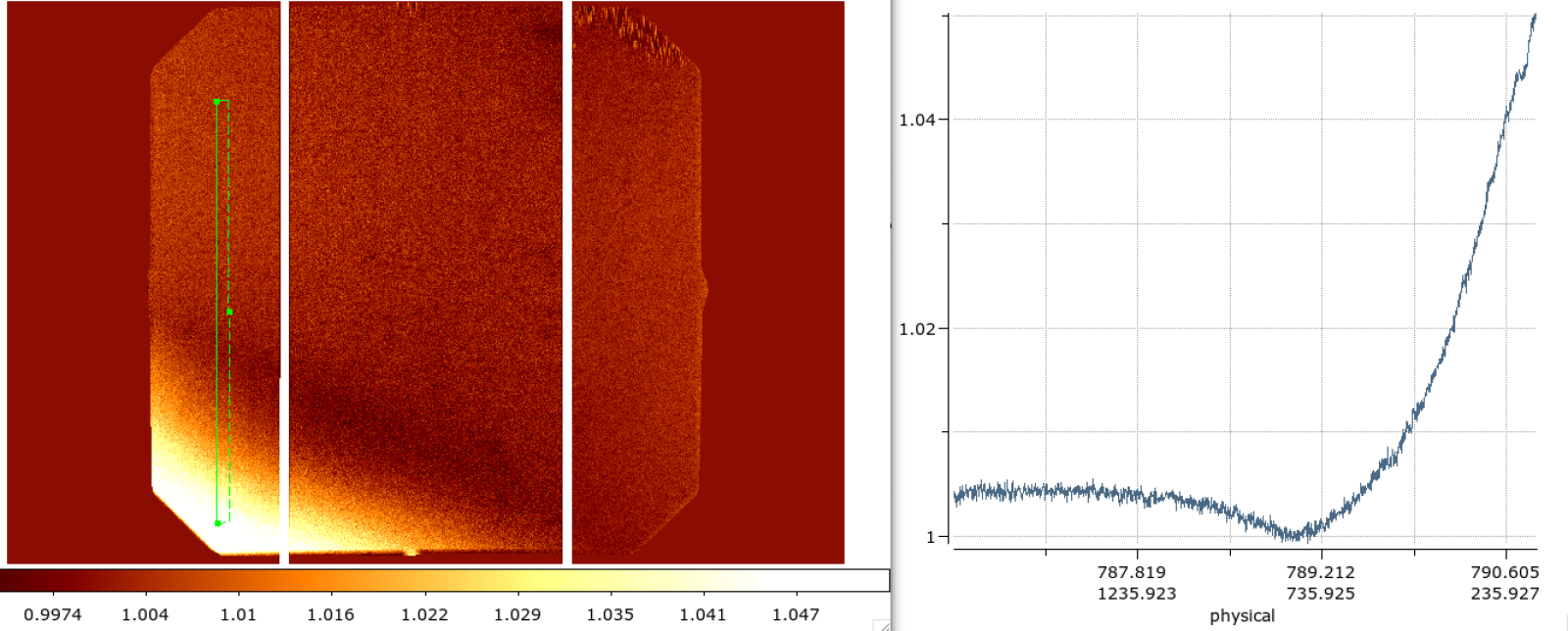
Example of the change in GMOS-N flat fields after the 5 March 2025 refill of collimator lens interfaces. The image shows the ratio of z'-band 2x2 twilight flats taken before and after the oil refill. The set of flats taken before the oil refill consists of frames N20250228S0373.fits to N20250228S0378.fits. The set of flats taken after the oil refill includes frames N20250306S0132.fits to N20250306S0138.fits. Both sets were reduced using DRAGONS before dividing the combined flat from 20250306 by the one from 20250228. The effect of the air bubble prior to the oil refill is noticeable in the lower left corner at an up to 5% level.
The air bubbles move with changes in telescope elevation and cass rotator angle, i.e. depending on the orientation of the GMOS collimator and camera lens groups with respect to the gravity vector. Since the oil is viscous, the bubbles have a long settling time of more than 30-40 min. For most configurations, the resulting obscuration will be prominent in the bottom part of the frame, but the exact location of the affected part is time-dependent. Typically, the bubble configuration and related obscuration will show small changes from frame to frame.
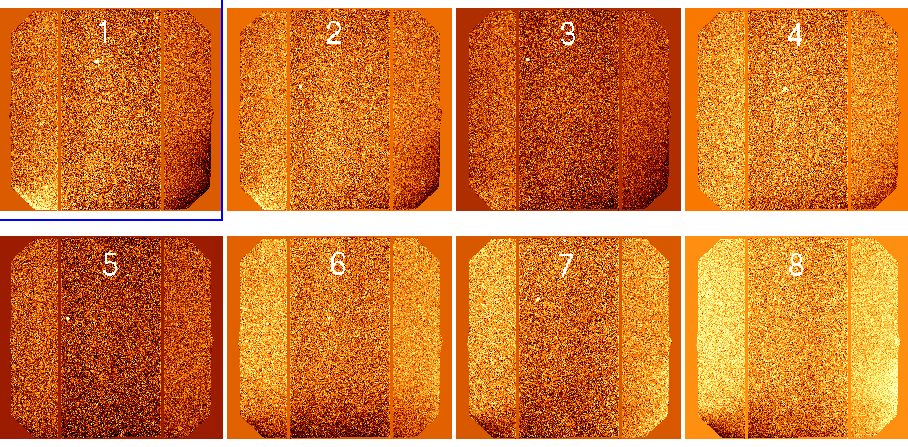
Eight consecutive i-band twilight flat exposures (labeled 1 to 8) after bias subtraction and flat fielding. The flat fielding is based on the average flat obtained by combining all eight exposures. Residuals after flat fielding due to the changing bubble configuration are most obvious in the lower left and right part of the frame. All eight consecutive twilight flat exposures were observed within less than 10 min. The images are not normalized and each color scale was chosen individually to highlight the residuals after flat fielding. (Note that these example twilight flats were taken in March 2018, during a period when GMOS-N was affected by a particularly extended air bubble after one of the collimator lens groups had suffered a major oil leak. While this lens group could be refilled with oil on 7 June 2018, less extended air bubbles in other lens groups remain.)
Dates of GMOS lens interface oil refills
The following table (under construction) lists dates of GMOS-N and GMOS-S lens interface oil refills. These dates should be considered when selecting twilight flats for GMOS imaging data.
-
Date GMOS-N GMOS-S 5 March 2025 Refill of 7 collimator lens interfaces 14 October - 12 November 2024 Refill of 5 camera lens interfaces during telescope maintenance shutdown 22 July - 22 August 2024 Refill of collimator lens interface during telescope maintenance shutdown 12-14 August 2019 Major work to gain access to third collimator lens group and perform refill 18 and 25 April 2019 Camera lens interface refill; no significant change in flat field quality 8 November 2018 Camera lens interface refill; no significant change in flat field quality August 2018 Major work to remove collimator and refill lens interfaces 7 June 2018 Collimator lens interface refilled after fixing a leak in the oil reservoir 14 September 2016 Middle two collimator lens interfaces filled 19 September 2014 Camera interface partly refilled as routine maintenance 16 January 2014 Camera interfaces filled 26 August 2009 Collimator lens group 1 and 2 filled 5 February 2007 Camera lens interface filled
Effects on GMOS data
The main effect of the air bubbles is an obscuration of light usually towards the lower part of the frame. The obscuration pattern can differ from exposure to exposure, depending on the telescope elevation and cass rotator angle and the long oil settling time. As a result, morning twilight flats may show a very different obscuration pattern than imaging exposures obtained in a different part of the sky at night.
Tests with a GCAL-illuminated pinhole grid mask in GMOS-N have demonstrated that the parts of the frame affected by the air bubbles show a degraded pinhole image quality in addition to light obscuration. Whether the same applies to on-sky data and whether the air bubbles can affect astrometric accuracy is currently under investigation.
Data reduction/observing strategies
The obscuration caused by the changing bubble configurations in the GMOS lenses can limit the flat fielding accuracy, in particular in imaging mode. The following recommendations may help to improve flat fielding during data reduction.
- Dark sky flat fields: Imaging programs are recommended to use a sufficient number of dithers, so that the imaging exposures themselves can be combined into a dark sky flat. The dark sky flat will provide the best-possible match to the air bubble configuration in the science data. This strategy may not be viable for programs targeting very extended objects.
-
For very extended objects, the best option is to include some off-target sky exposures in the science sequences, analogously to the case of NIR imaging. This strategy has proven to be effective with GMOS-S. Taking at least three dithered sky frames of a nearby field with a low density of bright sources is what gives the best results.
-
Twilight flat exposures: Twilight flats are typically observed in morning twilight using a range of telescope elevations (header keyword ELEVATIO) and cass rotator angles (header keyword CRPA). In order to enhance the flat fielding accuracy, it is recommended to select the subset of twilight flat exposures that most closely matches the obscuration pattern in the imaging frames. (Note that frames with matching elevation and cass rotator angle do not necessarily provide the best match in terms of the bubble obscuration due to the long settling time of the index-matching oil. A visual selection of matching twilight flats may be required.)
PIs of GMOS-N/GMOS-S programs who encounter issues with the data calibration or have questions about the best observing strategies are welcome to contact the GMOS-N or GMOS-S science teams at gmos_n_science 'at' gemini.edu or gmos_s_science 'at' gemini.edu.
R150 grating at GMOS-N
A new R150 grating (R150_G5308) was installed in GMOS-N in December 2016 (semester 2016B). This grating replaces the previous R150 grating (R150_G5306) which had developed an issue with the coating causing decreasing throughput in the blue part of the spectrum (see details below). The old R150 grating was available until June 2016.
The improved sensitivity of the new R150 grating is evident from the figure below, which shows a spectrum of the standard star Feige 34 taken with the new R150 grating on 2016 December 22 in comparison to a spectrum observed with the old R150 grating on 2015 December 31. Both spectra were taken using the 5.0" slit, 2x2 binning, and a central wavelength of 710 nm.

Details on the degradation of the previous R150 grating
During the GMOS North performance monitoring program in 2014B, the GMOS team noticed a feature appearing in the spectra of standard stars taken with the R150 grating, used for throughput determinations. Inspection of the grating showed that the coating looked cloudy. Below are two R-150 spectra from 2012 and 2014, for the standard star Feige 34, using the same configuration (R150/700nm/5.0'' slit/2x2 binning) and exposure time. With the grating positioned at 700nm central wavelength, the feature causes an absorption located between 480-620nm. (Data of Feige 34, taken on 2015 Dec 31, showed that there was no significant change in throughput compared to the 2014 data shown in the plot below.)
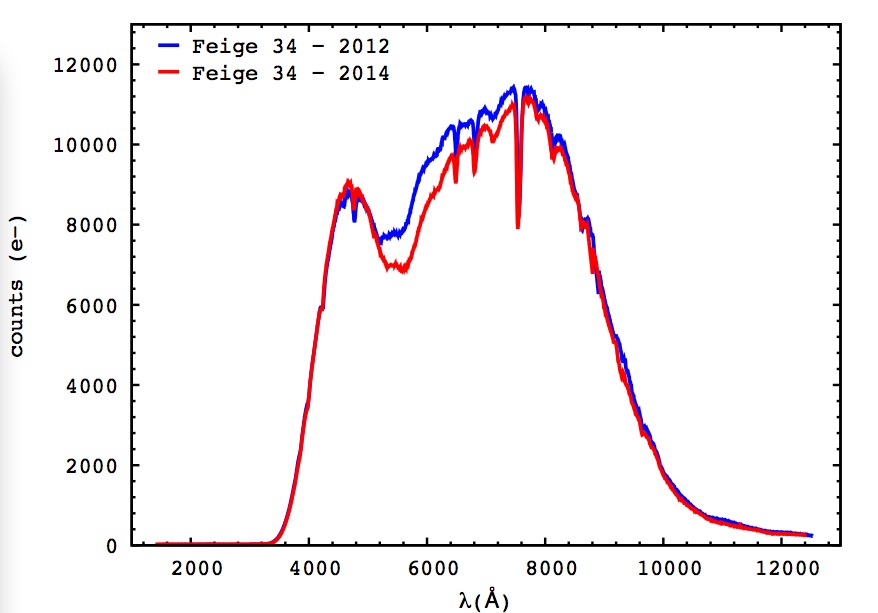
The next plot shows a comparison between two spectra for the same object, taken in 2010 and 2011. Note that these regard to the previous CCD installed at GMOS-N, which was replaced in late 2011.
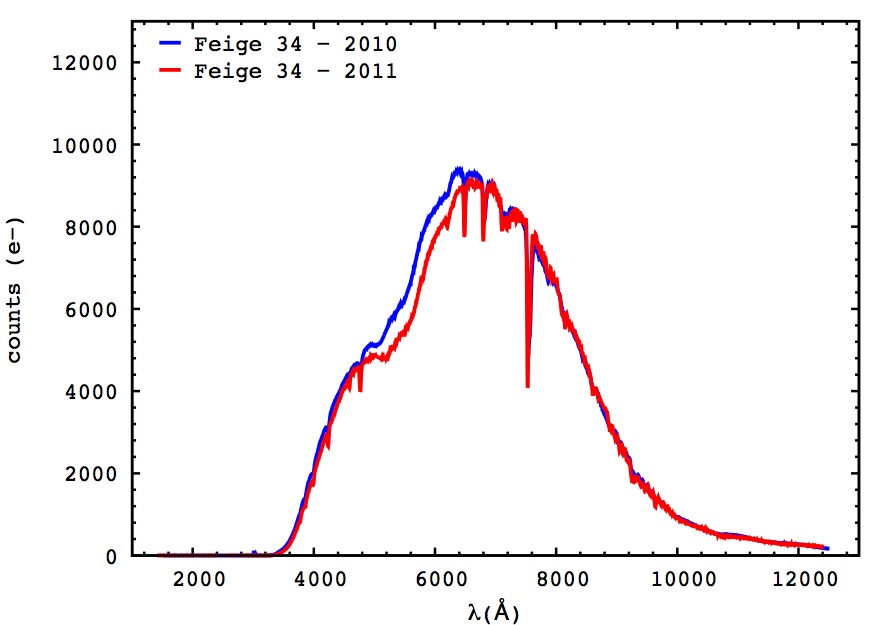
Users of the old R150 grating (R150_G5306) should be aware that there may have been a loss in sensitivity of about 0.5-1.0% per month in the affected region. Spectrophotometric standard stars can be used to calibrate the flux.
![GCALflat B600 400nm no filter. [GCALflat B600 400nm no filter]](/sciops/instruments/gmos/B600_400_none_GCALflat.jpg)
![GCALflat B600 400nm g filter. [GCALflat B600 400nm g filter]](/sciops/instruments/gmos/B600_400_g_GCALflat.jpg)
![GCALflat B600 400nm r filter. [GCALflat B600 400nm r filter]](/sciops/instruments/gmos/B600_400_r_GCALflat.jpg)
![GCALflat B600 400nm i filter. [GCALflat B600 400nm i filter]](/sciops/instruments/gmos/B600_400_i_GCALflat.jpg)
![GCALflat B600 400nm z filter. [GCALflat B600 400nm z filter]](/sciops/instruments/gmos/B600_400_z_GCALflat.jpg)
![GCALflat B600 850nm no filter. [GCALflat B600 850nm no filter]](/sciops/instruments/gmos/B600_850_none_GCALflat.jpg)
![GCALflat B600 850nm g filter. [GCALflat B600 850nm g filter]](/sciops/instruments/gmos/B600_850_g_GCALflat.jpg)
![GCALflat B600 850nm r filter. [GCALflat B600 850nm r filter]](/sciops/instruments/gmos/B600_850_r_GCALflat.jpg)
![GCALflat B600 850nm i filter. [GCALflat B600 850nm i filter]](/sciops/instruments/gmos/B600_850_i_GCALflat.jpg)
![GCALflat B600 850nm z filter. [GCALflat B600 850nm z filter]](/sciops/instruments/gmos/B600_850_z_GCALflat.jpg)
![GCALflat R400 400nm no filter. [GCALflat R400 400nm no filter]](/sciops/instruments/gmos/R400_400_none_GCALflat.jpg)
![GCALflat R400 400nm g filter. [GCALflat R400 400nm g filter]](/sciops/instruments/gmos/R400_400_g_GCALflat.jpg)
![GCALflat R400 400nm r filter. [GCALflat R400 400nm r filter]](/sciops/instruments/gmos/R400_400_r_GCALflat.jpg)
![GCALflat R400 400nm i filter. [GCALflat R400 400nm i filter]](/sciops/instruments/gmos/R400_400_i_GCALflat.jpg)
![GCALflat R400 400nm z filter. [GCALflat R400 400nm z filter]](/sciops/instruments/gmos/R400_400_z_GCALflat.jpg)
![GCALflat R400 850nm no filter. [GCALflat R400 850nm no filter]](/sciops/instruments/gmos/R400_850_none_GCALflat.jpg)
![GCALflat R400 850nm g filter. [GCALflat R400 850nm g filter]](/sciops/instruments/gmos/R400_850_g_GCALflat.jpg)
![GCALflat R400 850nm r filter. [GCALflat R400 850nm r filter]](/sciops/instruments/gmos/R400_850_r_GCALflat.jpg)
![GCALflat R400 850nm i filter. [GCALflat R400 850nm i filter]](/sciops/instruments/gmos/R400_850_i_GCALflat.jpg)
![GCALflat R400 850nm z filter. [GCALflat R400 850nm z filter]](/sciops/instruments/gmos/R400_850_z_GCALflat.jpg)
![GCALflat R831 400nm no filter. [GCALflat R831 400nm no filter]](/sciops/instruments/gmos/R831_400_none_GCALflat.jpg)
![GCALflat R831 400nm g filter. [GCALflat R831 400nm g filter]](/sciops/instruments/gmos/R831_400_g_GCALflat.jpg)
![GCALflat R831 400nm r filter. [GCALflat R831 400nm r filter]](/sciops/instruments/gmos/R831_400_r_GCALflat.jpg)
![GCALflat R831 400nm i filter. [GCALflat R831 400nm i filter]](/sciops/instruments/gmos/R831_400_i_GCALflat.jpg)
![GCALflat R831 400nm z filter. [GCALflat R831 400nm z filter]](/sciops/instruments/gmos/R831_400_z_GCALflat.jpg)
![GCALflat R831 850nm no filter. [GCALflat R831 850nm no filter]](/sciops/instruments/gmos/R831_850_none_GCALflat.jpg)
![GCALflat R831 850nm g filter. [GCALflat R831 850nm g filter]](/sciops/instruments/gmos/R831_850_g_GCALflat.jpg)
![GCALflat R831 850nm r filter. [GCALflat R831 850nm r filter]](/sciops/instruments/gmos/R831_850_r_GCALflat.jpg)
![GCALflat R831 850nm i filter. [GCALflat R831 850nm i filter]](/sciops/instruments/gmos/R831_850_i_GCALflat.jpg)
![GCALflat R831 850nm z filter. [GCALflat R831 850nm z filter]](/sciops/instruments/gmos/R831_850_z_GCALflat.jpg)